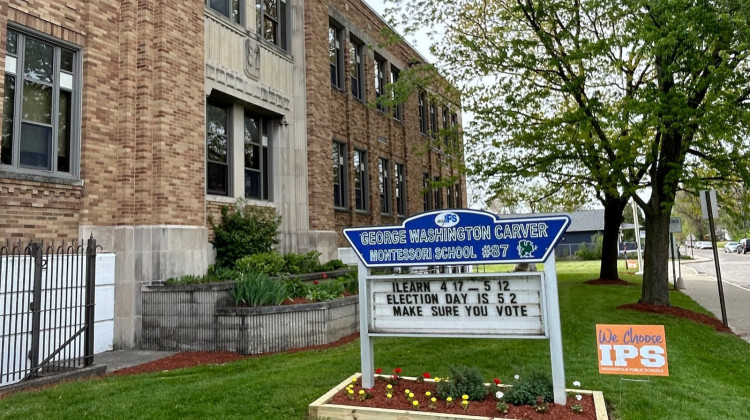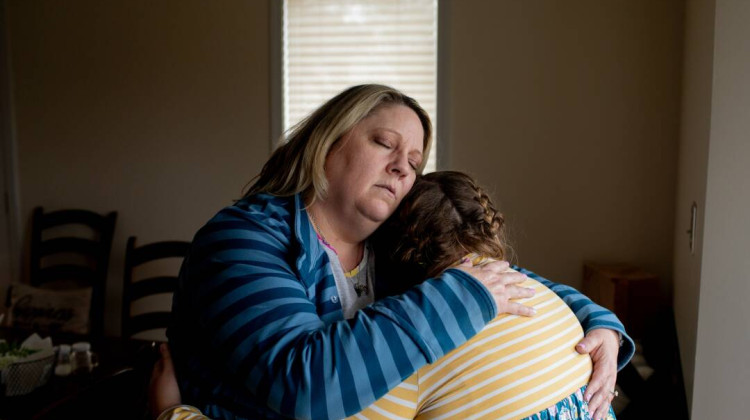
Indianapolis Public Schools Superintendent Aleesia Johnson explains a five-point proposal to reorganize the district's schools and academic offerings during a public meeting Thursday, June 23, 2002 at William Penn School 49.
(Eric Weddle/WFYI)Leaders at Indianapolis Public Schools Thursday proposed a set of sweeping changes to elementary schools and student enrollment policies in an effort to combat the dire challenges facing the district.
The plan, if approved, would impact nearly all elementary and middle schools students and toss out a controversial enrollment policy that favored families in affluent neighborhoods. It would also center the district’s promise of equitable access to well funded and resourced schools for all students.
During a meeting where the proposal was first shared publicly, Superintendent Aleesia Johnson said the city’s students need “hard, complex, and challenging” decisions made for their benefit.
“If you want to get to this vibrant, equitable, excellent school district we can’t continue to do what we are currently doing,” Johnson said. “It has to require us to change in some way. The question is how do we do that and what we are willing to do to get to that end state.”
The five point proposal comes after months of Johnson sharing data and assessments on the district’s finances, facilities, enrollment, student academics and opportunities. Her message has been clear: IPS faces a $25 million annual deficit by 2027 if changes are not made. The district operates on a 60 percent utilization rate of school buildings due to years of declining enrollment, and more than 20 percent of the buildings are in unsatisfactory or poor condition.
Grade level proficiency of IPS students is far below the state average and passing rates on state exams are even lower when disaggregated by racial demographics.
Reorganization proposal
Johnson stressed that her administration’s proposal was still open to changes. IPS families can submit comments via an online survey. A draft plan will be released in August. Then, a series of public meetings will be held in September for additional public input before a final proposal is shared with the school board. The board is expected to vote on the plan in late October.
The proposed reorganization plan is based on five changes:
Replicating schools Duplicate academically successful school models that already exist in the district. These schools would be located in the east, west and south sides of the city where fewer choices are available. Johnson referred to these schools as “instructional models that we find to be in high demand and higher performing.”
This includes schools with the Montessori or International Baccalaureate curriculum.
“We could grant access across the district in a way that we don't have today,” Johnson told WFYI in an interview about why replicating schools is a main goal. “And then increase the absolute numbers of those schools that have the higher demand and generally higher performing instructional models that our families have asked for.”
Make all elementary schools K-5, create 6-8 middle schools Schools are currently configured as a mix of K-6, K-8 and 7-8 grades. The reconfiguration would “expand seats” at high-demand elementary schools by removing upper grades and create a better academic and student experience for the middle grades, Johnson said.
No details were provided if some middle schools would be based on different types of curriculums offered in K-5, like International Baccalaureate.
“Basically this allows us to … just maximize that student enrollment to create a more robust experience for our students academically and from an enrichment standpoint as well,” Johnson said.
Close schools The closure or merger of schools with low enrollment and in poor condition would shift more students into more “warm, safe, well-kept” buildings, according to the district.
“If we're able to consolidate or merge schools that will allow us again, to have more students attending at a location to provide those more robust offerings for students academically and to allow for peer collaboration for teachers,” Johnson said. “And basically leverage our resources that are spread across many small schools now.”
Create enrollment zones Divide the district into yet-to-be determined geographic zones that would provide a choice of school models that families who live in each zone are eligible to attend. Currently, students are automatically assigned to their neighborhood school based on its boundary or can choose to attend most any magnet or choice school in the district no matter where they live.
“What this does is essentially create and replicate some of the conditions for success that our choice schools currently experienced and that our neighborhood schools don't have the benefit of experiencing,” Johnson said. “And so we believe it's a play for students' stability across our schools. If a student moves within a zone, they would not have to change schools, for example.”
End priority zone enrollment Currently the district enrollment lottery gives preference to families with homes located within a half-mile radius of a choice school option. This is known as the proximity priority, as families living in the boundary would be favored to win a seat in the district’s lottery enrollment for a high demand school.
IPS officials have struggled for years to address how the priority caused schools in the majority white Meridian-Kessler neighborhood to enroll far fewer children of color and economically disadvantaged students compared to the district's other schools.
Many questions unanswered
Thursday evening in the cafeteria of William Penn School 49, Johnson and district leaders explained the proposal to a roughly 30-member committee – composed of students, parents, staff and community members – who serve in an advisory capacity as part of the district's "Rebuilding Stronger" initiative.
Committee members asked many questions following the presentation.
What are the metrics for determining what a high-quality school is and for which students? Who will staff all of these newly replicated school models?
How will the enrollment zones be drawn without creating inequities?
Are there enough school buildings to handle a transformation to a 6-8 school? How do we protect communities from further disinvestments if their neighborhood school is closed?
Parent Lena Dickerson worries the consolidation of IPS schools could create a sort of education desert, just as lack of supermarket access in the city makes food deserts. But she believes some of the proposed changes are needed to improve the district.
“When it comes to making this school district the best it can be for the scholars, we’ve got to put all that adult stuff behind us. I don’t care what any adult wants or needs. Whatever is best for the scholars,” she said. “If one child does not have an equitable education, in my mind no child does.”
The community must buy into any plan for it to work, said Barato Britt, president of the Edna Martin Christian Center. Previous IPS administrations made major decisions that felt like the public had no say, Britt said.
This time he hopes the district can be transparent with more opportunities for the public to weigh in.
“I do believe our community is resilient and if we do communicate the right way at least we can contribute to the dialogue,” he said of the Martindale-Brightwood neighborhood. “Whether they will support it or fight against it, that is their prerogative to do. But we just have to commit to making sure they are engaged.”
District documents for the proposed reorganization plan are available here.
Contact WFYI education editor Eric Weddle at eweddle@wfyi.org or call (317) 614-0470. Follow on Twitter: @ericweddle.
 DONATE
DONATE






 Support WFYI. We can't do it without you.
Support WFYI. We can't do it without you.